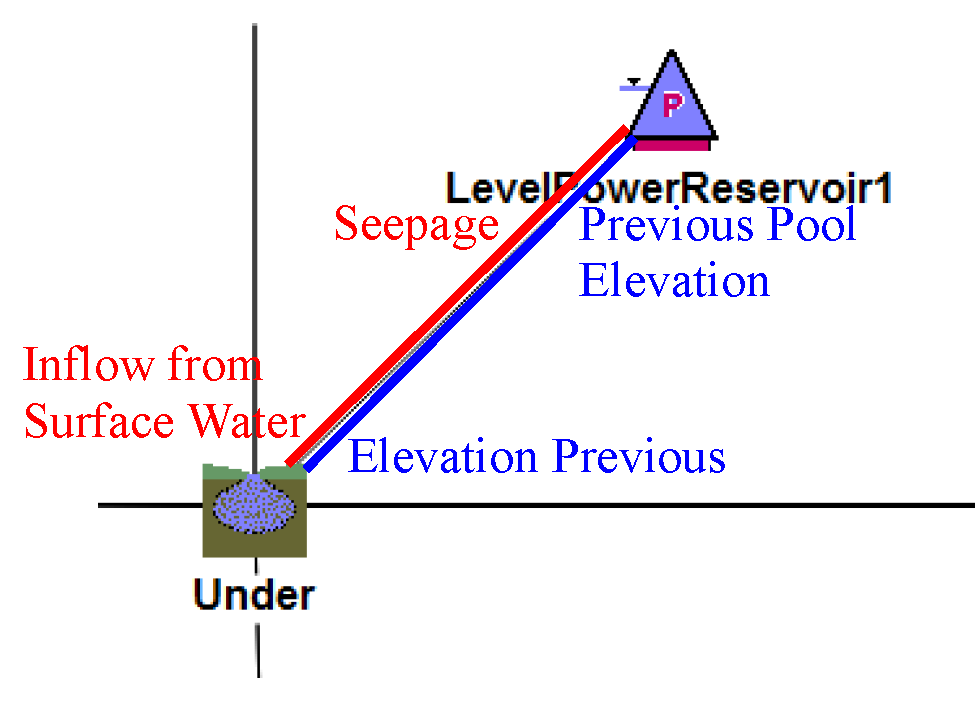Seepage
The Seepage methods are used to calculate the amount of water lost through the face of the dam. The volume of seepage computed during the execution of these methods affects the mass balance of the Reservoir.
None is the default for the Seepage category. It is used when the user does not want to calculate the flow of water through the face of the dam.
The Input Seepage method is used when it is desired to have the seepage slot as input or set by a rule.
Slots Specific to This Method
Seepage
Type: SeriesSlot
Units: FLOW
Description: Flow of water through the dam face
Information: Seepage is not included in the Outflow of the reservoir and will need to be linked separately if the water does in fact go downstream.
I/O: Input only
Links: Linkable
The Linear Seepage method calculates the seepage from the face of the dam. This calculation is based on the Pool Elevation of the Reservoir and specified coefficients.
Slots Specific to This Method
Seepage
Type: SeriesSlot
Units: FLOW
Description: Flow of water through the dam face
Information: Seepage is not included in the Outflow of the reservoir and will need to be linked separately if the water does in fact go downstream.
I/O: Output only
Links: Linkable
Seepage Coefficients
Type: TableSlot
Units: LENGTH, AREA per TIME, FLOW
Description: Coefficients in the linear equation for seepage
Information: The first coefficient (column zero) is the base elevation of the dam. The second coefficient is the slope of the linear equation for seepage. The third coefficient is the intercept of the linear equation for seepage.
I/O: Required input
Links: NA
Method Details
The calculation for Seepage in this method is fairly straightforward. A linear model is used. The coefficient are user inputs. The following equation is used to compute Seepage:

The Single Seepage Value method sets the seepage from the face of the dam equal to a scalar value.
Slots Specific to This Method
Seepage
Type: Series
Units: Flow
Description: Flow of water through the dam face
Information: Seepage is not included in the Outflow of the reservoir and will need to be linked separately if the water does in fact go downstream.
I/O: Optional Input
Links: Linkable
Single Seepage Value
Type: Scalar
Units: Flow
Description: seepage value to be applied to each timestep
Information:
I/O: Required input
Links: Not linkable
Method Details
This method is executed at the beginning of the run. For each timestep from the initial timestep through the end of the run (plus post run dispatching timesteps too), if the Seepage is not input, the Seepage is set equal to the Single Seepage Value.
The method will issue an error if there is not a valid value in the Single Seepage Value slot.
Note: This structure allows some flexibility. Seepage can be input/rules when necessary but will use the scalar value when not input.
This method is intended to be used when linking a Reservoir object with a Groundwater Storage object that uses the Head Based Boundary Condition method in the Solution Type category. See Head Based Boundary Condition for details.
Slots Specific to This Method
Seepage
Type: Series
Units: Flow
Description: Flow of water out of the reservoir, often into groundwater
Information: A positive value is flow out of the reservoir.
I/O: Output only if linked to a Groundwater object (typical); otherwise required input
Links: Must be linked, typically to Inflow from Surface Water on Groundwater object
Previous Pool Elevation
Type: Series
Units: Length
Description: Pool Elevation at the end of the previous timestep
Information:
I/O: Output only
Links: Typically linked to the Elevation Previous slot on a Groundwater object
Method Details
This method does not do any calculations; it just adds the appropriate slots. The Reservoir does provide the Previous Pool Elevation which is then linked to the Groundwater object Elevation Previous. The Groundwater object computes the Inflow from Surface Water, which is linked back to the Seepage slot on the reservoir. The Seepage is used in the Reservoir mass balance.
Figure 29.2

See Head Based Boundary Condition for details on how Seepage is calculated as Inflow from Surface Water on the linked Groundwater object.
Revised: 06/06/2025